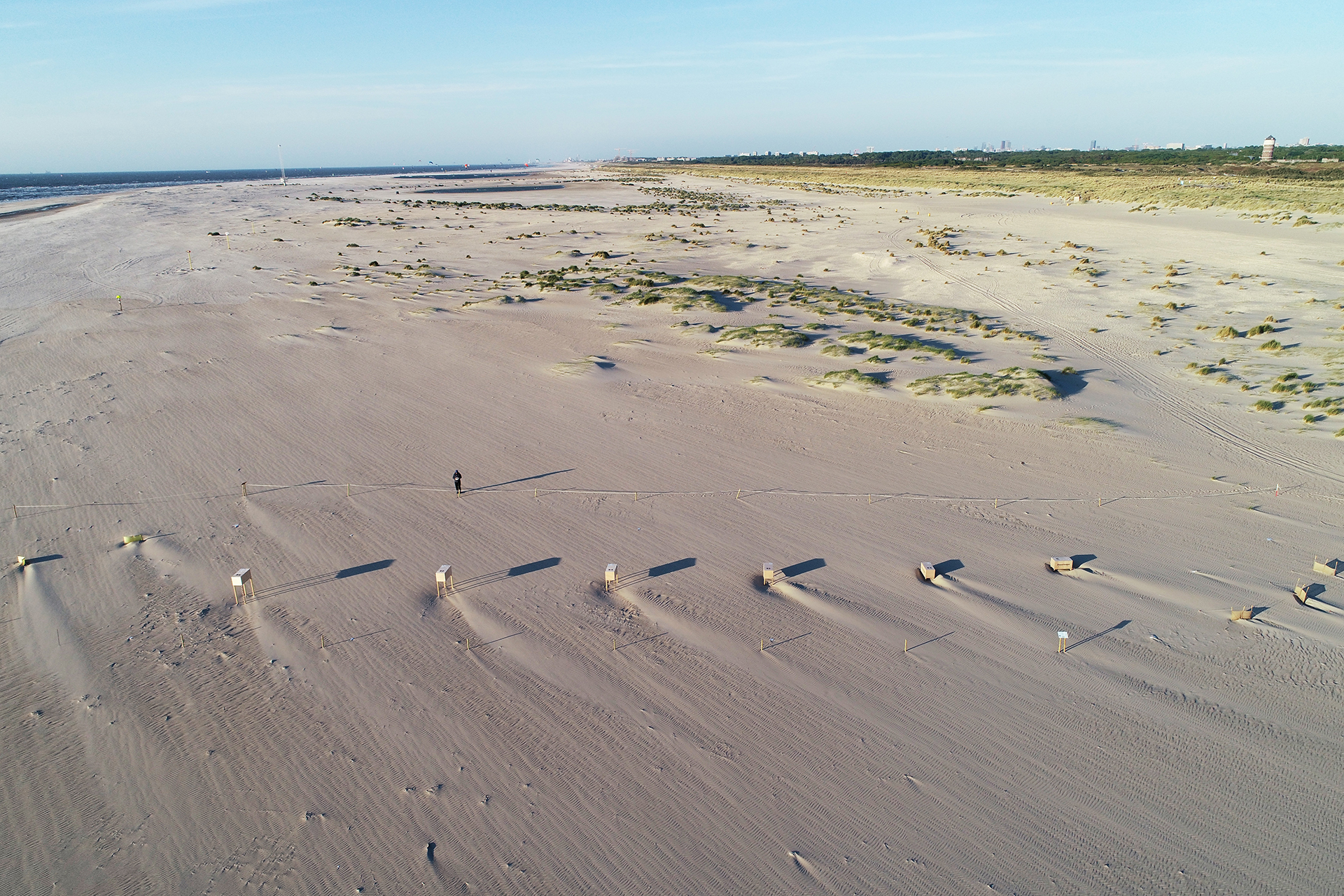Sea levels will continue to rise significantly over the coming decades. At the same time, urban development, leisure and nature are fighting for space on the coast. How can we make this coastal landscape as adaptive as possible? PhD candidate Janneke van Bergen has been researching just that in her dissertation entitled ShoreScape: A landscape approach for natural adaptation of urbanized sandy shores. "By giving space to natural processes involving wind and sand, we can make the coast safer and more diverse."
Sand nourishments – the mechanical suppletion of sand along the coast – is a proven way of protecting ourselves against rising sea levels. They deploy natural factors such as the wind and tides to strengthen the coast, allowing the dunes to form a barrier. Janneke van Bergen: "Although much is known about how sand nourishments work underwater, little is still known about how they contribute to dune formation via the wind.” Especially in urban areas where different functions – such as coastal defence, leisure and nature – often get in each other’s way. We wanted to investigate how they can actually support each other. In the ShoreScape project, funded by the Netherlands Organisation for Scientific Research (NWO), we have been looking at how exactly this accretion contributes to dune formation in urban areas and what natural design principles could support this process.
Building with nature
An important basis for the research is the ‘Building with Nature’ principle. This involves using natural material (sand) and processes (such as wind) to reinforce the coast and dunes as a barrier as opposed to solid defences such as dikes, for example. This Building with Nature approach offers more possibilities than coastal protection alone and led van Bergen to develop a new approach called 'ShoreScape': "We wanted to investigate how nourishments can not only reinforce dunes as a flood defence but also how we can merge them with other functions such as leisure and ecology through landscaping", she explains. And it needs to be done: "Recreational beach row housing, for example, currently blocks sediment flow to the dunes and causes fewer plants to grow, increasing wind erosion."
Besides this impact, van Bergen carried out fieldwork using scale models to enable her to study sand deposition around buildings. She also used geographical information systems (GIS) to analyse dune formation after nourishment from elevations maps. Van Bergen: "What stood out was that beach buildings in rows hold back a lot of sand so that dunes do not form as well. But we also discovered that pavilions on poles can actually cause the sand to blow higher up the dune, while separate beach cabins facing into the wind can promote more local sand deposition directly behind them, to widen the dunes."

So it is possible to direct dune formation by organising the landscape in a different way. A good example is the application of brushwood fences. Van Bergen: "In the Hondsbossche Dunes, GIS-analysis showed that brushwood fences were very successful at increasing dune growth directly after nourishment. You can use this design principle to start directing dune formation and build towards a specific profile. For instance, to speed up the reinforcement of the barrier and to create spaces for leisure or ecological functions, such as a terrace or wet dune valley. These fences are actually an old principle that we have now optimised for multiple use."
New design principles
Van Bergen translated the insights from the research into concrete design principles for building with nature on the coast. "This proactive approach to coastal design can help merge coastal reinforcement and urban development in a sustainable way. For example, by creating openings in beach building developments, by means of planting to stimulate dune formation or by matching the type of nourishment to the desired dune profile.
Now that we know more about how accretion principles work out in practice, a number of buttons to push have been added.
Seaside resorts like Noordwijk are typically places where flood defence, leisure and waterfront development have to share the same space. How can you protect an urbanized coast against rising sea levels and keep the seaside resort looking attractive at the same time? Van Bergen: "You would prefer not to have a dune barrier so high that it blocks the sea view from the boulevard. As an alternative, you could gradually expand the dune barrier by means of nourishment to create a new scenic waterfront where dunes and urban development work together." With major (mega-)nourishments that last for twenty years or more, you can even align coastal functions with them, as the Walcheren case study has shown. You then start adapting urban planning to work with shoreline development from the sand nourishment: Form Follows Sediment. Around the core of the mega-nourishment, wide beaches for sport and leisure are created and, in the end, less sand is added in order to encourage upward sediment flow for nature development.
More possibilities with sand
The starting point of Building with Nature is that the coast can grow naturally with the rising sea levels through sand nourishment. "But we are looking further than that: can’t we get more out of sand than just safety?" asks van Bergen. "If municipalities know what design options there are – such as widening or heightening of dunes, for example – one can look at what suits the region best and see how one can design and adapt the coast accordingly. It’s great to be able to do this with nature and the wind." According to van Bergen, there is still a lot to be gained after nourishment: "When it comes to Building with Nature principles, I am a true 'believer'. Now that we know more about how accretion principles work out in practice, a number of buttons to push have been added. With these design principles, we can allow the coast to grow naturally, with safety, leisure and nature complementing each other. I would love to carry out pilot projects in order to put this into practice."
Published: May 2023
More information
Janneke van Bergen will be receiving her doctorate on 16 June with her dissertation entitled ShoreScape: A landscape approach for natural adaptation of urbanized sandy shores.
The thesis can be found on this DOI link.
Header image: Brushwood fences as a design principle promoting dune formation as a natural defence and waterfront. | Source J. van Bergen TU Delft, visualisation OKRA.

